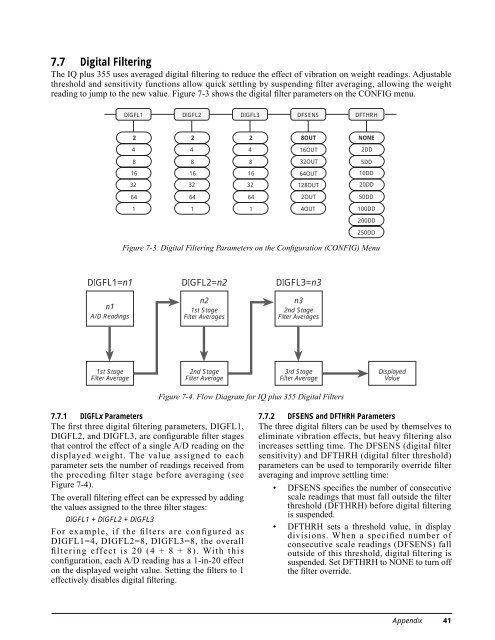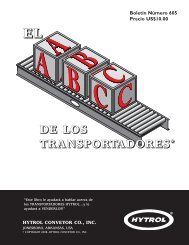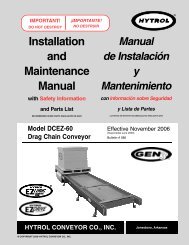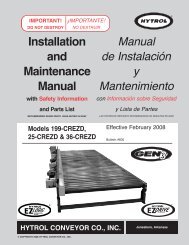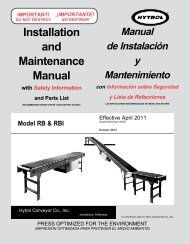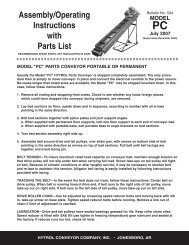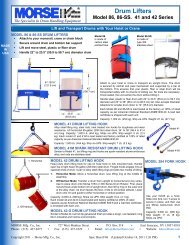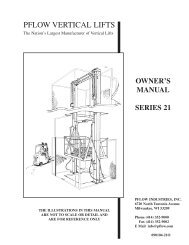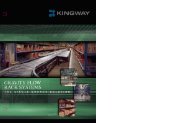IQ plus® 355 - Cisco-Eagle, Inc.
IQ plus® 355 - Cisco-Eagle, Inc.
IQ plus® 355 - Cisco-Eagle, Inc.
You also want an ePaper? Increase the reach of your titles
YUMPU automatically turns print PDFs into web optimized ePapers that Google loves.
7.7 Digital Filtering<br />
The <strong>IQ</strong> plus <strong>355</strong> uses averaged digital filtering to reduce the effect of vibration on weight readings. Adjustable<br />
threshold and sensitivity functions allow quick settling by suspending filter averaging, allowing the weight<br />
reading to jump to the new value. Figure 7-3 shows the digital filter parameters on the CONFIG menu.<br />
DIGFL1<br />
2<br />
4<br />
8<br />
16<br />
32<br />
64<br />
1<br />
DIGFL2<br />
Figure 7-3. Digital Filtering Parameters on the Configuration (CONFIG) Menu<br />
7.7.1 DIGFLx Parameters<br />
The first three digital filtering parameters, DIGFL1,<br />
DIGFL2, and DIGFL3, are configurable filter stages<br />
that control the effect of a single A/D reading on the<br />
displayed weight. The value assigned to each<br />
parameter sets the number of readings received from<br />
the preceding filter stage before averaging (see<br />
Figure 7-4).<br />
The overall filtering effect can be expressed by adding<br />
the values assigned to the three filter stages:<br />
DIGFL1 + DIGFL2 + DIGFL3<br />
For example, if the filters are configured as<br />
DIGFL1=4, DIGFL2=8, DIGFL3=8, the overall<br />
filtering effect is 20 (4 + 8 + 8). With this<br />
configuration, each A/D reading has a 1-in-20 effect<br />
on the displayed weight value. Setting the filters to 1<br />
effectively disables digital filtering.<br />
2<br />
4<br />
8<br />
16<br />
32<br />
64<br />
1<br />
DIGFL3<br />
2<br />
4<br />
8<br />
16<br />
32<br />
64<br />
1<br />
DFSENS DFTHRH<br />
8OUT<br />
16OUT<br />
32OUT<br />
64OUT<br />
128OUT<br />
2OUT<br />
4OUT<br />
DIGFL1=n1 DIGFL2=n2 DIGFL3=n3<br />
n1<br />
A/D Readings<br />
1st Stage<br />
Filter Average<br />
n2<br />
1st Stage<br />
Filter Averages<br />
2nd Stage<br />
Filter Average<br />
n3<br />
2nd Stage<br />
Filter Averages<br />
3rd Stage<br />
Filter Average<br />
Figure 7-4. Flow Diagram for <strong>IQ</strong> plus <strong>355</strong> Digital Filters<br />
NONE<br />
2DD<br />
5DD<br />
10DD<br />
20DD<br />
50DD<br />
100DD<br />
200DD<br />
250DD<br />
Displayed<br />
Value<br />
7.7.2 DFSENS and DFTHRH Parameters<br />
The three digital filters can be used by themselves to<br />
eliminate vibration effects, but heavy filtering also<br />
increases settling time. The DFSENS (digital filter<br />
sensitivity) and DFTHRH (digital filter threshold)<br />
parameters can be used to temporarily override filter<br />
averaging and improve settling time:<br />
• DFSENS specifies the number of consecutive<br />
scale readings that must fall outside the filter<br />
threshold (DFTHRH) before digital filtering<br />
is suspended.<br />
• DFTHRH sets a threshold value, in display<br />
divisions. When a specified number of<br />
consecutive scale readings (DFSENS) fall<br />
outside of this threshold, digital filtering is<br />
suspended. Set DFTHRH to NONE to turn off<br />
the filter override.<br />
Appendix 41


